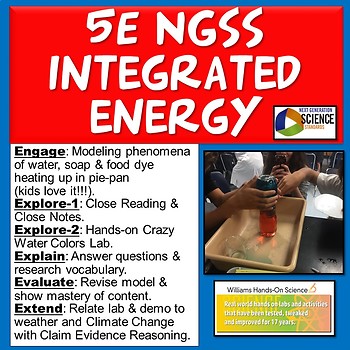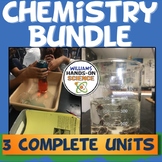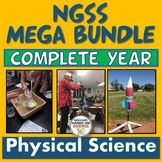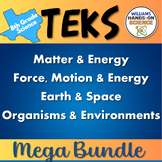Conduction Convection Radiation Heat Transfer Activity MS-PS3-3 MS-PS3-4
- Zip
What educators are saying
Also included in
- This NGSS bundle has everything you need for Structure and Properties of Matter (complete distance learning unit), PS1.B PS3.A Chemical Reactions Google Ready Bundle (complete distance learning unit) Chemical Reactions, Definitions of Energy, States of Matter, Periodic Table, Chemical Reactions, ConPrice $69.97Original Price $115.20Save $45.23
- This bundle is a time-saving, comprehensive and user-friendly complete year bundle for physical science Teachers that will streamline your teaching experience effortlessly! Every lesson is meticulously planned and just a click away. This extraordinary bundle is a treasure trove of engaging resourcesPrice $176.00Original Price $311.50Save $135.50
- The TEKS 8th Grade Bundle is a comprehensive resource for teaching science mainly in Texas, but it can be used in any state. This bundle includes over 60 hands-on, rigorous, engaging, and phenomena-driven lessons that cover the TEKS standards for 8th grade science. The lessons are designed to help sPrice $160.00Original Price $321.15Save $161.15
Description
This product will WOW your students and challenge them! This integrated week long activity has real life applications and is engaging, rigorous, fun and easy prep! Your students will master energy transfer after this activity!
It’s NGSS aligned, it’s integrated, it’s a rigorous week long 5E and relatively easy prep! I also include 12 pages of very detailed notes, a key and my email if you have any questions. Read below for the details.
The following concepts are included:
-Energy
-Kinetic Energy
-Potential Energy
-Energy Transfer
-Heat
-Temperature
-Convection
-Conduction
-Radiation
- Gravitational Potential Energy
- Energy of Position and Motion
-Weather
-Climate Change
NGSS Standards:
Disciplinary Core Ideas
PS3.A: Definitions of Energy
PS3.B: Conservation of Energy and Energy Transfer
ESS2.D: Weather and Climate
ESS3.C: Human Impacts on Earth Systems
ESS3.D: Global Climate Change
Science and Engineering Practices
Developing and Using Models
Engaging in Argument from Evidence
Science Knowledge Is Based on Empirical Evidence
Cross Cutting Concepts
Systems and System Models
Energy and Matter
Pie-Pan Demo: Modeling Phenomena for the Engage section.
I would first watch this clip on YouTube. It gives you a good idea on what you see and how it works. It’s also a great resource for many other NGGS activities.
https://www.exploratorium.edu/snacks/pie-pan-convection As the water, soap and food dye mixture heats up, I tell the students to think about what the particles are doing and write those thoughts down in the form of a model. In NGSS, a model is a simplified representation of a system that can explain and help make predictions regarding a phenomenon. I encourage the students to make models that are mental representations of what the particles are doing and how the energy moves them. As it heats up, I ask, “How are the particles moving?” and “What do you think is causing them to move?” and “On a larger scale, what does this look like to you?” and many of them say a hurricane, atmosphere, weather, etc. I tell them to write those thoughts down in the form of a model with words, arrows and explanations (Examples are in teacher notes). It’s important to tell them that there are no write or wrong answers. The kids really get captivated by the swirling food dye and soap. It only happens for several minutes and then it becomes homogeneous.
We share and discuss their models and their explanations written below the models. After the discussion we move on to “Explore-1”
Explore-1: Close Reading and Cloze notes.
Students do the cloze notes and we talk about the answers. I relate it to the pie-pan as a system where energy is increasing and similarly, the earth as a system is gaining excess heat that is being trapped due to Climate Change. I then segue into the Lab.
Crazy Water Colors Lab: Explore-2
I refer to this video and the procedure at the same time to help the students understand what they are to do, but I pause it before they pull the card so the students don’t know what will happen until they actually do it themselves. I highly recommend you take a look. https://www.youtube.com/watch?v=86ChgK38EIA
Crazy Water Colors: Explain
The questions for the “Explain” are challenging and it takes them at least 20 minutes to do them. For numbers 4 and 5 they use websites to understand conduction, convection and radiation. The questions prompt the students to relate those vocabulary terms to the lab and weather. This is a scaffold for their revised model in the Evaluate section on the next page.
Crazy Water Colors: Evaluate
In “Evaluate” students revise their model from the first page. However, I now require them to include conduction, convection, heat, temperature and kinetic energy in their model. The application of these terms to the pie-pan demo must be accurate. I tell them they can’t just write the words with arrows and point it at their model. They have to illustrate the application of the concepts with their mental model.
Crazy Water Colors: Extend
Students read one of two articles and do a Claim Evidence Reasoning graphic organizer. One is about Climate Change increasing extreme weather events and the other is about the 2017 California Wildfires.
Thank you for taking a look!
Please follow me on TpT for new products and check me out on Instagram to see this product in action!
https://www.instagram.com/williamshandsonscience/
Take a look at my bundles
Physical Science Growing Bundle
Take a look at some other products in my store:
Elements, Atoms, Compounds and Molecules Card Sort
Flipping the Classroom Periodic Table Frayer Models
Physical Science Scaffolded Notes
NGSS Speed, Time, Distance, Acceleration and Graphing Worksheets
Physics Speed, Time and Distance Problems
STEM Paper Airplane Competition
Physical Science Scaffolded/Guided Notes for a Year + 8 PREZIS
NGSS Kinetic and Potential Energy Card sort








